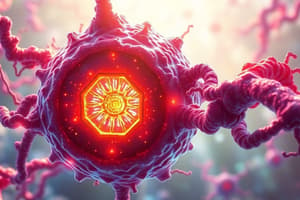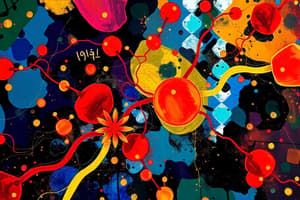Podcast
Questions and Answers
What is the role of receptor proteins in cellular communication?
What is the role of receptor proteins in cellular communication?
- To transport signaling molecules across the cell membrane.
- To directly alter the genetic material in the nucleus.
- To initiate a signal transduction pathway that leads to a cellular response. (correct)
- To physically connect two adjacent cells through their membranes.
Which signaling mechanism involves communication between neighboring cells over short distances?
Which signaling mechanism involves communication between neighboring cells over short distances?
- Autocrine signaling
- Paracrine signaling (correct)
- Contact-dependent signaling
- Endocrine signaling
What distinguishes endocrine signaling from other types of cellular communication?
What distinguishes endocrine signaling from other types of cellular communication?
- It requires direct cell-to-cell contact.
- It involves the secretion of molecules that act over long distances. (correct)
- It uses membrane-bound receptors for communication.
- It operates strictly through cell-cell recognition.
What type of junctions facilitate direct contact signaling between animal cells?
What type of junctions facilitate direct contact signaling between animal cells?
What best describes the process of autocrine signaling?
What best describes the process of autocrine signaling?
Which of the following types of signaling relies on physical contact between cells?
Which of the following types of signaling relies on physical contact between cells?
What is the first step in the signal transduction pathway?
What is the first step in the signal transduction pathway?
What is the primary function of plasmodesmata in plant cells?
What is the primary function of plasmodesmata in plant cells?
What is the primary characteristic of hydrophilic extracellular signal molecules?
What is the primary characteristic of hydrophilic extracellular signal molecules?
Which extracellular signal molecule is considered hydrophobic?
Which extracellular signal molecule is considered hydrophobic?
What type of receptors are most likely to be activated by large polypeptide hormones?
What type of receptors are most likely to be activated by large polypeptide hormones?
How do hydrophilic signaling molecules typically transmit signals inside target cells?
How do hydrophilic signaling molecules typically transmit signals inside target cells?
What is a notable feature of small or hydrophobic extracellular signals compared to hydrophilic signals?
What is a notable feature of small or hydrophobic extracellular signals compared to hydrophilic signals?
What is a characteristic feature of endocrine signaling?
What is a characteristic feature of endocrine signaling?
How do different cells respond to the same signaling molecules?
How do different cells respond to the same signaling molecules?
What are the two major classes of extracellular signal molecules?
What are the two major classes of extracellular signal molecules?
In cellular signaling, what role do second messengers typically play?
In cellular signaling, what role do second messengers typically play?
Which is an example of a hormone that is involved in regulating the maturation of ovules?
Which is an example of a hormone that is involved in regulating the maturation of ovules?
What role does receptor specificity play in cellular signaling?
What role does receptor specificity play in cellular signaling?
Which type of signaling molecule is least likely to be quickly effective on cellular activity?
Which type of signaling molecule is least likely to be quickly effective on cellular activity?
Which of the following statements about hormonal signals is true?
Which of the following statements about hormonal signals is true?
What is a consequence of a cell having multiple types of receptors?
What is a consequence of a cell having multiple types of receptors?
What determines the range of signals a cell can respond to?
What determines the range of signals a cell can respond to?
Which hormones are produced by the pituitary gland and impact reproductive processes?
Which hormones are produced by the pituitary gland and impact reproductive processes?
What is the primary function of steroid receptors in the context of gene expression?
What is the primary function of steroid receptors in the context of gene expression?
Which characteristic applies to ligands that can serve as extracellular signal molecules?
Which characteristic applies to ligands that can serve as extracellular signal molecules?
How do cell responses that do not involve changes in gene expression typically manifest?
How do cell responses that do not involve changes in gene expression typically manifest?
Where are intracellular receptors primarily located before binding with a ligand?
Where are intracellular receptors primarily located before binding with a ligand?
What type of signaling response is primarily associated with changes in gene expression?
What type of signaling response is primarily associated with changes in gene expression?
Which of the following best describes the role of extracellular signal molecules?
Which of the following best describes the role of extracellular signal molecules?
What type of molecules are considered to be hydrophobic and can passively diffuse across the cell membrane?
What type of molecules are considered to be hydrophobic and can passively diffuse across the cell membrane?
What is the significance of the binding of a ligand to intracellular receptors?
What is the significance of the binding of a ligand to intracellular receptors?
What is the primary role of the hormone-binding domain in a steroid receptor?
What is the primary role of the hormone-binding domain in a steroid receptor?
Which domain in the steroid receptor interacts specifically with coactivators?
Which domain in the steroid receptor interacts specifically with coactivators?
What initiates the production of nitric oxide (NO) in the blood vessel walls?
What initiates the production of nitric oxide (NO) in the blood vessel walls?
What role does cGMP play in the mechanism of nitric oxide signaling?
What role does cGMP play in the mechanism of nitric oxide signaling?
What distinguishes the steroid receptor superfamily from other transcription factors?
What distinguishes the steroid receptor superfamily from other transcription factors?
What occurs when nitric oxide diffuses into adjacent smooth muscle cells?
What occurs when nitric oxide diffuses into adjacent smooth muscle cells?
What is NOT a characteristic of steroid receptors?
What is NOT a characteristic of steroid receptors?
What step follows the diffusion of nitric oxide into smooth muscle cells?
What step follows the diffusion of nitric oxide into smooth muscle cells?
Flashcards are hidden until you start studying
Study Notes
Receptor Protein
- Receptor proteins bind and recognize signaling molecules on the surface of target cells
- These molecules cause a cellular response via a signal transduction pathway
Signal Transduction Pathways
- A signal transduction pathway is a series of steps by which a signal on a cell's surface is converted into a specific cellular response
- External signals are converted into a form that can elicit a response inside the cell, which can include gene expression and the nucleus
Cell Communication Methods
- Direct contact: Cell-cell or cell-matrix contact using membrane-bound receptors
- Indirect:
- Autocrine signaling: Signaling molecules act on the same cell that secreted them
- Paracrine signaling: Signaling molecules act on nearby cells
- Endocrine signaling: Signaling molecules are secreted by endocrine cells and travel through the circulatory system to act on target cells at distant body sites
Types of Signaling
- Contact-dependent signaling: Cells maintain an intimate membrane-to-membrane interface with direct contact
- Cell-cell recognition: Cells make direct physical contact through signal molecules lodged in the plasma membrane
- Direct contact:
- Gap junctions: In animal cells
- Plasmodesmata: In plant cells
Three Types of Chemical Signaling
- Long-distance signaling:
- Endocrine signaling: Hormones secreted by endocrine cells travel through the circulatory system to act on target cells at distant body sites
Example of Endocrine Signaling
- The pituitary gland in the brain secretes FSH and LH hormones that coordinate the maturation of ovules and endometrium
Cells Respond to a Limited Set of Signals
- A typical cell in a multicellular organism is exposed to hundreds of different signal molecules in its environment
- Each cell responds selectively to a mixture of signals, disregarding some and reacting to others, according to its specialized function
- A cell’s response to a signal molecule depends on whether it possesses a receptor for that signal
Complexity in Cell Signaling
- Binding to one type of receptor protein can cause a multitude of effects in the target cell
- Signaling cascades amplify signals and distribute them so they influence several processes in parallel
Extracellular Signals
- The majority of extracellular signal molecules are hydrophilic molecules
- They cannot pass through the phospholipid bilayer of the plasma membrane
- These molecules bind to cell-surface receptors
- Examples include large polypeptide hormones (insulin, glucagon, growth hormones) and small charged compounds (adrenaline)
- These use a second messenger system
Intracellular Receptors
- Some extracellular signal molecules are small or hydrophobic and can diffuse across the plasma membrane
- Examples include steroid hormones, lipids, hydrophobic amino acids, and vitamin A
- They activate intracellular enzymes directly or bind to intracellular receptor proteins in the cytosol or nucleus
- These receptors are referred to as nuclear receptors
- Most steroid receptors are transcription regulators that bind to DNA promoters and turn on specific genes
Extracellular Signal Molecules as Ligands
- Extracellular signal molecules can be proteins, peptides, amino acids, nucleotides, steroids, fatty acid derivatives, or dissolved gases
- They bind either to cell-surface receptors or to intracellular enzymes or receptors
Cell Responses to Signals
- A cell’s response to a signal can be either fast or slow
- Fast responses do not require changes in gene expression, and include changes in cell movement, secretion, or metabolism
- Slow responses involve changes in gene expression and the synthesis of new proteins
Intracellular Receptors
- Intracellular receptors are cytoplasmic or nuclear proteins
- They often reside in the cytoplasm and move to the nucleus upon ligand binding
- Signal molecules are lipid-soluble molecules
- They are involved in the regulation of gene expression
Components of a Steroid Receptor
- Hormone-binding domain: Binds to the ligand
- DNA-binding domain: Binds to DNA to activate gene expression
- Domain that interacts with coactivators: Affects gene expression by interacting with other transcription factors
Cell Signaling by Hydrophobic Signals
- Nitric oxide (NO) can diffuse across the membrane and signal by binding directly to an enzyme inside the target cell
- NO triggers smooth muscle relaxation in a blood vessel wall
- This dilation of blood vessels is a key mechanism for blood vessel regulation
Nitric Oxide Signaling Pathway
- Acetylcholine is released from nerve cell endings in the blood vessel wall
- Acetylcholine binds to acetylcholine receptors on endothelial cells
- Endothelial cells are stimulated to produce NO from arginine
- NO diffuses into adjacent smooth muscle cells
- NO binds to guanylyl cyclase, which is a receptor in smooth muscle cells
- Activated guanylyl cyclase catalyzes the production of cGMP from GTP
- cGMP causes smooth muscle relaxation
Studying That Suits You
Use AI to generate personalized quizzes and flashcards to suit your learning preferences.



